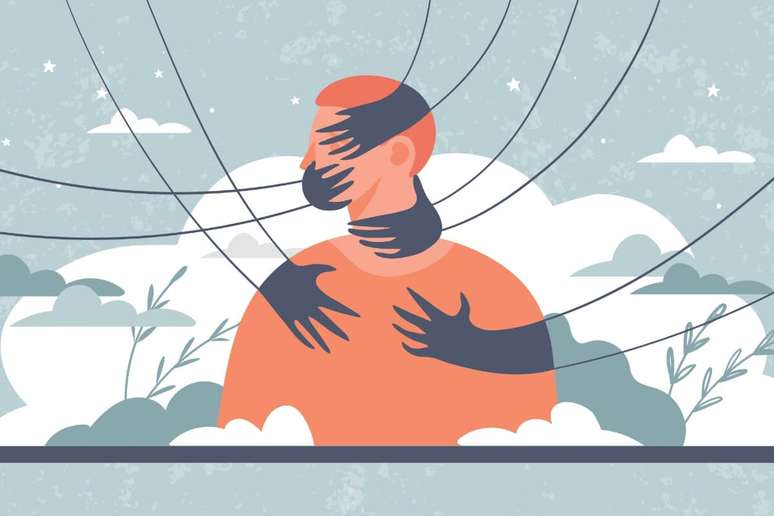Reconciling yourself with memories and wounds is a way to free yourself and experience the new
Trauma, in Greek, means wound. Experiences that, because they are so painful or overwhelming, penetrate the autonomic nervous system. And, once incorporated into the mind and body, they influence how we see ourselves, as well as the world, life and our relationships. We begin to see things through a shattered lens. Can you imagine the degree of distortion in the images and how painful it is to look at them?
Gabor Maté, doctor and therapist specialized in trauma treatment and addictions, prefers to formulate that trauma is not what happens to us, but rather what this event generates within us. Therefore, he avoids classifying unpleasant things and comparing suffering.
A catastrophe, an accident, violence can be as traumatizing as the emotional distance from a mother or father, even if present and functional. Everyone knows where it hurts. And how much does it cost to live in high tension, hypervigilant, as if the lurking danger would push us to fight or flee at any moment?
Reliving a trauma
These disturbing impressions recorded in our being tend to persistently trigger unpleasant, if not unbearable, emotional and physical reactions. The intriguing aspect is that they can resurface in the face of any incident that resembles the original event that hurt us or even in the face of widespread sensations, which evoke passages buried in the deepest layers of the psyche. In both cases, the feeling we feel is that of threat and lack of protection, which leads us to relive the same agony.
Since childhood, or even from intrauterine life, we carry emotional circuits rooted in our brain which, in these moments, take control, generating intense and uncontrolled reactions of anger, fear, shame, distrust, aversion, etc.
Translated by tachycardia, tremors, difficulty breathing, sweating… They impose themselves because the rational and calming parts of the brain are deactivated. We feel like we are being dominated by something beyond our control and it seems like nothing will change the way we feel.

In search of restoration
The truth is that, while we carry around unresolved problems, we remain hostage to the effects of events on us. “Until resolved, trauma keeps us stuck in the past, robbing us of the richness of the present moment and limiting who we can be,” Maté writes in the book The myth of normality: trauma, health and healing in a sick world (Sextant).
This state undermines the notion of self-esteem, poisons relations, compromises the enjoyment of life itself, as well as our wholeness. And, to deal with the difficult feelings perpetuated by trauma, we repress our emotions or disconnect from them, while also freezing our ability to feel the good things in life.
This is why the tendency towards escapist and addictive behavior is so common in so many places. If we can’t do anything about the facts, fortunately we can offer ourselves adequate care regarding our interiority. In this sense it is worth examining the signs that pulsate within us.
Compassionate inquiry method
In the documentary The wisdom of trauma (available on thewisdomoftrauma.com), Gabor Maté explains the method he developed called “compassionate investigation”. According to him, the truth is within every person and, by asking the appropriate questions, the therapist helps people to correct the focus of their perceptions, both physical and emotional, restoring the authentic and healthy being that until then could not express itself and, thus, they have compressed their potential for success.
Emphasize that the goal is not to get rid of the traumatic memory, but to help the person expand to have space for all their emotions, to be able to recognize and accept them with compassion for themselves. “Trauma requires an enormous expenditure of energy not to feel pain. As we heal, this same energy is released throughout our lives,” she offers.
Clinical psychologist Liana Netto confirms: “If it weren’t for the evolutionary pressure of trauma, we would still be unicellular organisms. Therefore, in the face of very challenging situations, We are driven to give birth within ourselves to a previously unknown strength, which brings with it the elegant gift of survival. Therefore, traumas are also the midwives of the most incredible parts of us,” says the teacher of Somatic Experiencing (SE) Training, a naturalistic and neurological approach to trauma resolution created by psychologist Peter A. Levine.
The body is an ally
Sergio Oliveira, a training teacher at Somatic Experiencing (SE) and CEO of the Brazilian Trauma Association (ABT), recommends that anyone wanting to release an emotional wound seek out a professional who works specifically with post-traumatic stress disorders.
It’s just that some psychic wounds are buried in deep parts of memory, inaccessible through words and thoughts. But the body can give us access to them through its sensations, as postulated by Levine, whose method is adopted by ABT.
The therapist who adheres to this guideline calmly and gently guides his patients through a process called trauma renegotiation. He invites you to observe yourself, to feel the smallest bodily sensations, emotions and images that can visit you.
In this way they discover new internal states, as well as abilities compatible with who they have become during their journey so far. By feeling stronger and able to face adversity, as well as being able to feel and tolerate sensations that previously weakened them, they ease the emotional storm by gaining self-confidence.
They thus have the opportunity to understand themselves and choose how they want to respond to the traumatic memory in a therapeutic context, thus allowing the episode to resolve itself safely. “With great attention, the person will be able to process what they were unable to do in the past, so that something suspended is resolved and they can free themselves from a pattern that held them back, opening up a range of new responses,” says Oliveira.
Liana gives the example of a man whose alcoholic father was a heavy alcoholic violent in its development. “He felt trapped in a passivity and helplessness that prevented his competence from thriving, and he was able to restore power, vitality, creativity, and dignity, as well as much healthier patterns of romantic relationships,” she says.

Scrolling again
Neither denial nor identification. We must seek a narrative consistent with the resources we have today, giving rest to the painful memories, which will happen when we reconcile with them. “This wholeness restores continuity between past and future and encourages motivated perseverance, realistic optimism, and forward movement in life,” Levine writes in the book Trauma and Memory: Brain and body in search of the living past (Summus editorial).
As the patient develops body awareness, the window of tolerance to stimuli that previously triggered a reactive and even aggressive state increases, leading to withdrawal and isolation in relation to others. Gradually he will open up and stop behaving this way, as he will deal with situations better and will have the time he needs to process them, as well as realizing when he is heading towards some unhealthy symptom or behavior.
“I believe this is a great evolution, because it expands the capacity for vitality, to feel fuller and to make choices in one’s life,” says the specialist. Having a support network, as we know, makes the difference in this reconstruction.
Writing the trauma
Art can also be a way to release what hurts us. Therefore, the writer Jarid Arraes created the “Writing Trauma” workshop. Since he studied Psychologyresearch the topic, especially when the shock occurs in childhood.
“I believe in the power of writing as a means to overcome one’s traumas and also as a creative force that portrays our society and even the most difficult issues, building bridges between those who write and those who read, because reading also helps us in self-reflection and processing our pain”, he explains.
Jarid has also permeated his literature with this issue. He spent a lot of time reading books by professionals in the fields of mental health and neurology, autobiographies of victims and even fiction, all to write Broken body (Alfaguara), a novel that addresses physical and psychological abuse of children.
“These have been intense years, immersed in a deeply sensitive issue that requires our attention. What I want and hope is that this topic touches more people, not as victims, but as agents of understanding and social transformation,” he hopes. With care and love, what has been shattered can, in fact, return to wholeness. Who said no?
By Raphaela de Campos Mello – Vida Simples Magazine.
Journalist. After studying the trauma, he felt the caress of self-compassion. And a sweet relief in the chest.
Source: Terra
Ben Stock is a lifestyle journalist and author at Gossipify. He writes about topics such as health, wellness, travel, food and home decor. He provides practical advice and inspiration to improve well-being, keeps readers up to date with latest lifestyle news and trends, known for his engaging writing style, in-depth analysis and unique perspectives.








